We climb in the humid afternoon up a rutted and overgrown logging road, the sky mostly sealed off by a canopy of tree branches, sunlight leaking through dense greenery in elongated shafts. The hike up Dents Run is not quite a half mile long, but the six representatives of Finders Keepers LLC, a Pennsylvania-based treasure-hunting business, string out as climbers on Everest. Co-owner Denny Parada, 69, brings up the rear, hobbling a bit and breathing forcefully. He’s wearing a Finders Keepers polo and a camo baseball cap and shorts and has a handgun strapped to his hip. “Snakes,” he’d explained.
Dents Run is an unincorporated community in Benezette Township in rural Elk County, in northwestern Pennsylvania. We’re on a wooded slope, one knobby vertebra among thousands along the spine of the Appalachians. The overgrown road we’re ascending, known locally as Snooks Trail, is a lingering scar from a decades-old logging operation, though most recently it has served as the access point to Parada’s lifelong obsession.
About halfway up, Denny’s 37-year-old son and business partner, Kem, hollers and points. An elk is perched on a steep slope above the trail, 50 feet up. It stands unmoving, staring us down, as the group stops to gaze back. A few of us snap photos and turn uphill; the elk stays locked on us as we trudge away.
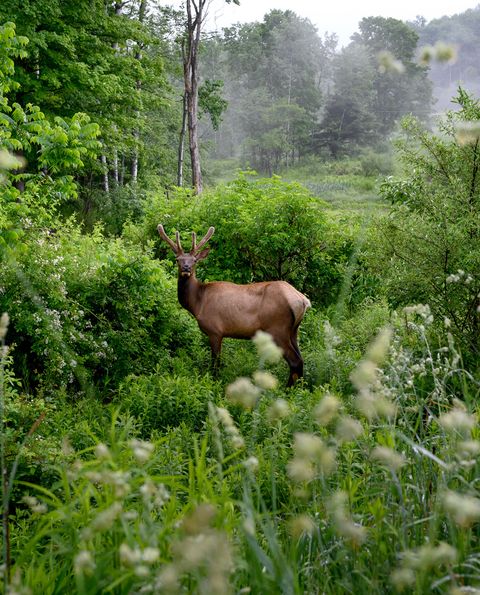
An elk stands still near a trail in Dents Run, Pennsylvania, June 8, 2021.
Anyone who is inclined to anthropomorphize might infer some type of omen in this. Dents Run has an enigmatic history—a lump of new-growth forest that’s unremarkable in every way, except that it birthed a tale of, among other things, a psychic, a cache of buried gold, Confederate sympathizers, an army of FBI agents, and a furtive overnight dig.
Once we reach our destination, Parada points to the slender cave opening that first propelled his quest, and the location maybe 15 yards away where four years ago the FBI authorized a sizable excavation. Parada is a paunchy nub of a man with a gray mustache and goatee. He uses an early-aughts-style flip phone and chews tobacco. His recitations of his exploits blend boyish wonder with the copious f-bombs of a case-hardened cynic. At the moment, he’s describing the extensive testing he did on this very ground to confirm the presence of gold.
Advertisement - Continue Reading Below
“I just think beyond any other treasure hunters,” he says, “because… I’m not going to claim I’m smart, but I do more experiments than anybody.”
As he speaks, Dwayne Kelly, a member of Parada’s entourage of full-timers, part-timers, and volunteers, is circling a nearby slope with dowsing rods. Parada describes Kelly as a kind of savant with this ancient if scientifically debunked method of searching for underground metal.
“I need everybody’s opinion here,” Kelly says. The rest of the group clusters around him.
“He’s finding something,” Denny notes, but then continues with his recounting of events from years earlier. Before he gets much further, Warren Getler splits away and joins us. Getler is the group’s default scholar, an expert in geophysics and buried Civil War treasure. “We think there’s something going on,” he says. “Look at the similarity to this up there. And look, the potential tunnel right there. We’re getting a strong signal.”
They begin scanning the site with a Discovery Treasure-Finder 900, a metal detector capable of locating objects as deep as 12 feet underground. Denny ejects a wad of Skoal-tinted saliva. “Dwayne, what did you do?” he shouts in mock exasperation, holding his arms wide.
“I’m making you rich, buddy,” Kelly calls back.
“He does this constantly to me,” Parada says.
Later, he says, grinning, “You’re actually on a treasure hunt. I didn’t expect this to happen.”
Advertisement - Continue Reading Below
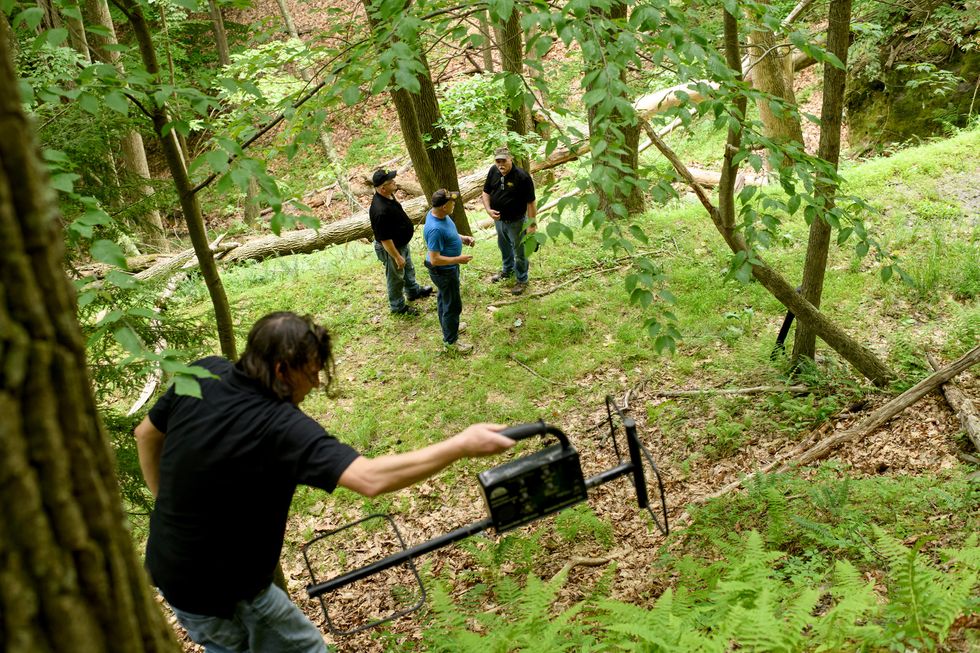
Jason Ammerman of Finders Keepers uses a two-box metal detector as he examines an area above the other team members near the Dents Run dig site.
It’s maybe the most surprising thing he’s said all day. This is Parada’s stock in trade, after all, and his adventures on Dents Run have gained traction in newspapers and on television worldwide. But treasure hunting is the longest of long games, and whether Kelly has actually found anything will not be determined today—or, most likely, anytime soon.
As with just about everything Parada gets involved with, the answers are tantalizingly close—just a few feet below ground—but just out of reach.
Advertisement - Continue Reading Below

The drama at Dents Run started, as these stories do, with a fortuitous meeting. It was March 1974. Denny Parada, a native of nearby Philipsburg and a recent graduate of commercial-art school, had taken a job at a W.T. Grant department store, but his passions lay elsewhere. His grandmother was an antiques dealer, and he was fascinated with old objects, including a mysterious river stone he’d found as a child and kept. He thought it might be a Native American artifact. “I always loved this kind of stuff—historical stuff,” he says.
In his 20s, Parada bought treasure-hunting magazines and, during idle weekend hours, began sleuthing the mysteries they posed. One article in particular caught his attention because it was fascinating, and it was local: the legend of Dents Run gold.
The story has tentacled off in various ways over generations of retellings, and details have been added or amended over time. But the essence of the saga, as recounted in a 2019 Mt. Zion Historical Society booklet, remains the same. In 1863, the U.S. government’s War Department authorized a shipment of 50-pound gold bars—26 in all—from San Francisco to the Philadelphia Mint to finance the war effort. To avoid Confederate activity, the supply wagons carrying the gold were diverted from a route across southern Pennsylvania into the hilly, forested north. Following the advice of a local guide, the commander, Lt. James Castleton, and his sergeant, Mike O’Rourke, attempted a shortcut over the mountains using an 1842 map titled “Wildcat Country.”
Advertisement - Continue Reading Below
Things quickly went sideways. The logging road they were on led to a trail junction that wasn’t shown on the map. They picked the most promising option, but that petered out, leaving them to navigate a wilderness of tall virgin pines. Eventually they encountered a steep hillside that the wagons couldn’t navigate. The decision was made to send for help, pack out as much gold as possible, and bury the rest.
Most of the men went missing, and the gold never arrived in Philadelphia. Pinkerton detectives who were dispatched to investigate never recovered the cache (although they did find two and a half bars). The National Archives holds no record of the shipment, but the legend of the lost gold “has captivated the attention of thousands of people over the past 150 years,” the historical society reports. And waves of fresh ambition, fortified by the forward march of metal-detecting technology, have continually fueled new searches.
Dennis Parada was just another dreaming amateur in 1974 when his employer hired Michael Malley—who performed at the time as the psychic Professor M.G. Malley—to present a “delightfully entertaining ESP presentation.” Parada missed the presentation during his shift in the furniture department. He thought the notion of a psychic was ridiculous anyway.
He was on his lunch break when Malley wandered by. Parada brandished a copy of Treasure Magazine with the Dents Run story, so one of his colleagues asked Malley whether he could help locate the gold. “What I’m about to tell you next,” Parada says of this encounter, would “change our lives forever.”
Advertisement - Continue Reading Below
Malley ran a finger over the article while Parada stood behind him thinking, What a bunch of bullshit. But Malley then went into a trance and began speaking in voices—Parada believes they were soldiers who’d lost the fateful gold shipment. Malley picked up the atlas Parada had with him, and with eyes looking toward the ceiling, brought a pen down on a spot where he instructed Parada to go. Later, using a soil sample Parada had collected, Malley told him to look for a cave entrance.
Parada became a believer, but the search ran aground when he was unable to locate the cave. He became preoccupied with life—opening several businesses, including an antique-furniture store, and raising a family. But he never forgot Dents Run; Kem, born in 1985, grew up hearing bedtime stories about that gold.
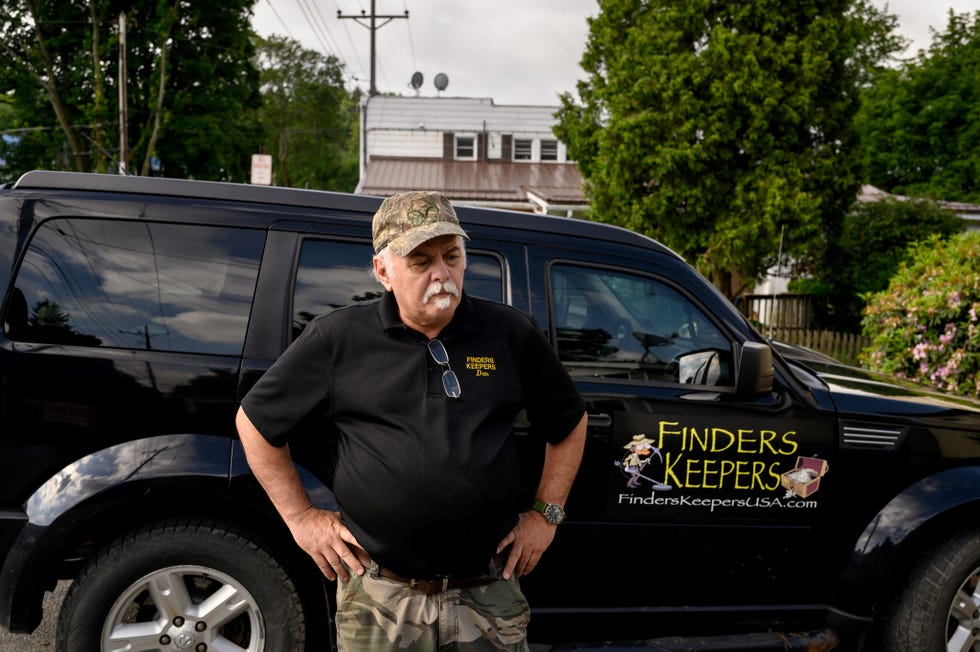
Denny Parada, co-owner of the Finders Keepers treasure-hunting business.
Advertisement - Continue Reading Below
Fast-forward 30 years. It’s 2004, and Denny is sitting in a bar watching TV with a friend, Scott Farrell. The show is about treasure hunting, and it reminds him of Dents Run. Farrell asks Parada whether he wants to take another look. Soon afterward, they hike up the hill and Parada waves in the direction of the purported cave. Before he gets far looking further uphill, Farrell yells that he found something. “Don’t joke with me, Scott,” Denny calls back.
But Farrell (who has since died) had found it: a horizontal slit of an entrance on the slope below the logging road, just wide enough for a person to crawl in. Parada surmises that work crews had inadvertently sealed over the entrance when constructing the road, and erosion over subsequent decades had opened it back up. A trickle of water leaked from the opening.
Inside the grotto, Parada says, they found a hand-built wall of stacked stones. Their flashlight beams played over scorch marks on the ceiling, apparently from a torch. They later discovered Civil War-era bullets and other artifacts nearby, adding to their suspicion that troops had visited the site during the conflict.
Farrell had found it: a horizontal slit of an entrance on the slope below the logging road, just wide enough for a person to crawl in.
Advertisement - Continue Reading Below
Malley had advised them that the cave was 32 feet deep. The stacked-stone wall was at 15 feet, but later Kem Parada was able to remove enough stones to find a second chamber behind it—and that one was also 15 feet deep. At the back of that chamber they located a shaft, but further excavation posed too much of a cave-in risk, so they backed off. The cave was muddy and damp—a claustrophobe’s nightmare—but the Paradas were exultant, feeling they were close to finding something, possibly the mythical cache of gold. Focusing on the ground above, they investigated further using a metal-detecting device called a GPL 200. (GPL stands for “ground penetrating locator.”) The user embeds stakes connected by wire around a plot of ground. By pulsing electrical current through the stakes, the device gauges the presence of metals and minerals below, based on how strongly the underground elements oppose—or “resist,” in geophysical terms—the charge. Gold, silver, and copper are highly conductive, so the lower the resistivity reading, the higher the odds that they’ve been discovered.
The Paradas’ GPL revealed a highly conductive metal mass just off to one side of the underground chamber. They also tested the site using ground-penetrating radar. That device emits radio frequencies into the earth’s surface, which then either bounce back or are absorbed, depending on what they encounter. To estimate what lies beneath, the device’s computer calculates the signal strength of the reflected radio waves and the amount of time they took to bounce back.
Advertisement - Continue Reading Below
In 2010, the Paradas hired Terence Hamill, founder and chief geophysicist of GeoSearches Inc., an Ohio-based firm specializing in subsurface geophysical surveys. Hamill detected “a large metallic anomaly at depth, differentiated from the surrounding geology,” reinforcing Parada’s suspicion that something was there. “We could see that there was something completely different down there, and it could well be precious,” Hamill says.
Over the next nine years, Denny and Kem Parada visited Dents Run about 300 times, capturing more than 100 readings. Kem says the results were unmistakable: “It all screamed gold at this same location.”
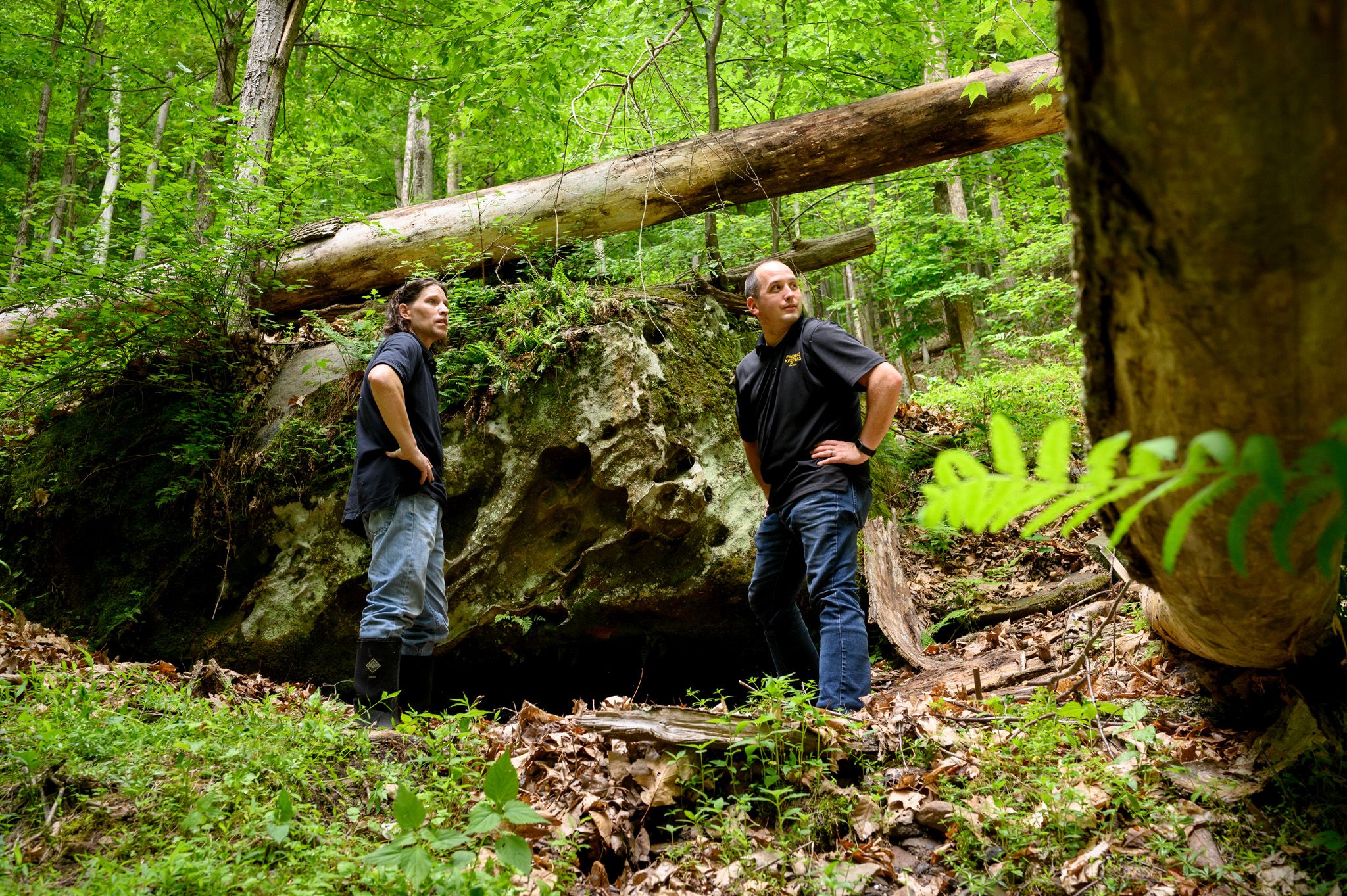
Kem Parada, right, stands with Jason Ammerman near a cave where they believe they discovered a fabled Civil War gold cache in Dents Run.
Advertisement - Continue Reading Below

When they’d first found the cave entrance, the Paradas had been hobbyists—guys out hunting for treasure on weekends and during their spare hours. The site is on state land overseen by the Pennsylvania Department of Conservation and Natural Resources, and DCNR officials initially seemed unfazed by their activities, signing off on everything they asked to do short of sinking shovels into earth. “They kind of just let us do our thing,” Kem says.
Eventually the Paradas became such a regular presence at Dents Run that state officials sent them a letter identifying them as professional treasure hunters. The Paradas embraced the classification by forming Finders Keepers.
Bolstered by this veneer of legitimacy, they began to more intensively explore the question of whether they had actually struck gold. They secured permission from the DCNR to drill bore holes from above with non-commercial-grade equipment. “We basically spent years Swiss-cheesing this mountaintop,” Kem says.
As they drilled their 16th hole, the bit stopped about five and a half feet down. This was odd, because they were typically exploring as far as 12 feet down. They switched out their three-quarter-inch masonry drill bit for a one-inch bit, and Denny switched the machine onto high speed and put all his weight into it. The bit sent up a squealing sound—metal on metal, he says—and stopped dead. He shut the drill down to let it cool, but when he returned after lunch, the bit was so firmly wedged into something that it took two and a half days to extract it.
Advertisement - Continue Reading Below
That was when things started to get weird.
When he finally retrieved the bit, yellowish smears were melted onto the end—a “gold shine,” as he puts it, though there was no way to test for it. At this point anyone would be sorely tempted to just start shoveling earth, but they were committed to doing things by the book. On November 1, 2010, Denny asked the DCNR for permission to drill a two-inch hole into the location and drop a camera inside. This time the answer was no. An official said they needed “to see gold metal on a drill bit in sufficient quantity to convince us” that such invasive procedures were warranted.
That was when things started to get weird. They’d been leaving their equipment at the site—including a generator and metal detectors—but someone began taking pieces of gear, including trail cameras hanging from trees, GPL stakes, and an extension cord. But the thieves missed one camera, and the images from it stunned Parada: The people removing his equipment were uniformed DCNR personnel. Parada demanded that his gear be returned, and over the course of several heated exchanges, his relationship with the state agency became adversarial. Parada even found evidence that he believes shows that people attached to the agency conducted their own dig on the site, though not in the place he had identified as holding the cache.
This escalation brought steep consequences. In 2014, the DCNR sent a certified letter demanding that the Paradas cease all activity there. “Once we drove down and hit the gold and had them on site, that’s when things changed,” Denny says. “It’s just big government bureaucratic stuff that pisses me off.”
Advertisement - Continue Reading Below
That summer, the Paradas took a meeting with a staff member of the Pennsylvania legislature who offered to facilitate a dig permit. The person (whom the Paradas decline to name) claimed to be acting on behalf of individuals in state government—someone who controlled money going to DCNR, and someone working in the governor’s office. But there was a condition: The Paradas had to kick back three gold bars, or 12 percent of the haul, Denny says. He captured the incident on video, and the Paradas’ attorney, Bill Cluck, reported the incident to the FBI, but no one was ever charged.
Frustrated and stymied by the DCNR ban, the Paradas turned to other projects. More than four years passed, and they might have eventually forsaken Dents Run. But then, in November 2017, Denny’s phone rang.

Warren Getler had come across the Paradas’ Dents Run adventure on a treasure-hunting online bulletin board. He was instantly intrigued. Getler had worked as a journalist for the Wall Street Journal and Bloomberg News, among other outlets, and had coauthored a book, Rebel Gold, about the Knights of the Golden Circle. The KGC, he told Denny, was a quasi-military secret society that took hold in the South and Midwest during the Civil War. Its founders opposed the abolitionist movement and sought to create a new slave-owning nation that encompassed the Gulf of Mexico and Caribbean as a counterweight to the North. Operatives looted Union shipments to raise money for the cause, and then stashed plundered gold and silver in various locations around the country. Getler says many of those caches remain intact today—and he told Parada he believed the Dents Run gold was stolen by a KGC-affiliated group in the North called the Copperheads.
Advertisement - Continue Reading Below
Getler opined that while there was likely gold at Dents Run, the fable associated with its presence there is apocryphal. The gold was likely stolen and hidden there, he said, and the story of the lost supply wagons is, in part, a KGC “waybill”—a cryptic, coded message meant to indicate the location of a cache to insiders.
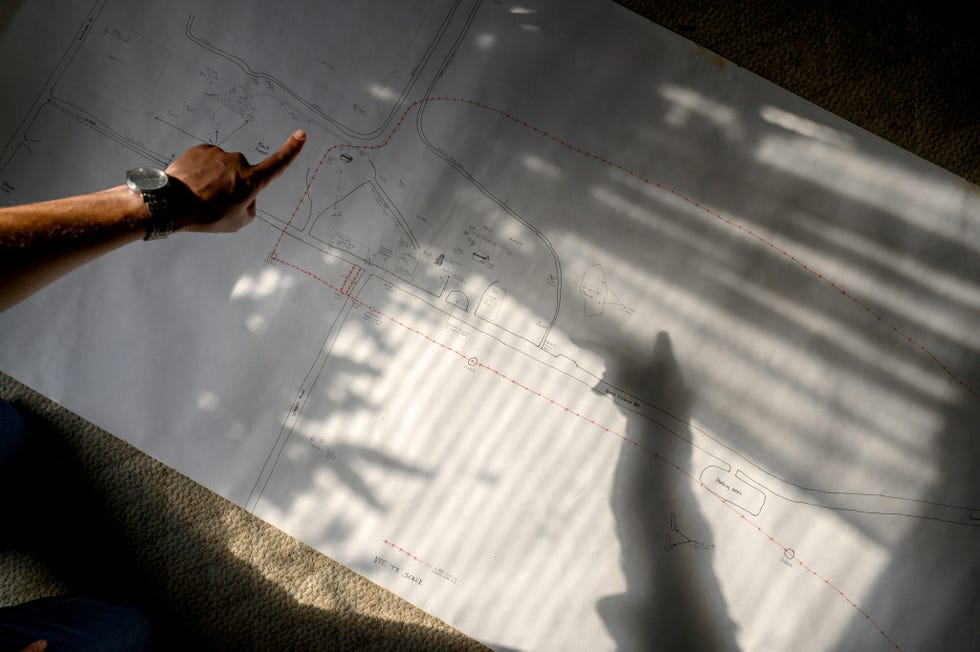
Warren Getler points to a map of a site he’s exploring with the Finders Keepers team.
The Getler-Parada alliance formed with the suddenness and intensity of a thunderclap. They talked nearly every night for the next two months, and came to a powerful realization: Getler’s narrative gave them another avenue for pursuing the treasure. If the gold bars had come from the U.S. Mint, they were federal property. And the Feds could invoke eminent domain in order to dig on state land.
Advertisement - Continue Reading Below
Getler eventually left journalism to join a tech startup that focused on geophysics and subsurface target detection in Washington, D.C. He knew that the electrical-resistivity-sensing equipment Denny was using had certain limitations because the Dents Run soil contained high clay and water content. But the possibilities were compelling—so much so that he offered to arrange a meeting with the FBI to explore a possible gold recovery at the Pennsylvania site.
On January 26, 2018, the Paradas met Getler in Philadelphia. They ate slices of pizza together, then headed to the U.S. Attorney’s office, where they met two agents from the bureau’s Art Crime Team and an assistant U.S. attorney. The agents spent an hour listening and looking over the Paradas’ stuff. They were initially skeptical, Denny says, “but when I showed them what I had”—including various instrument readings—“they were more convinced.” Getler provided a colloquium on the KGC.
When they’d finished, Special Agent Jake Archer told them, “I just want to be clear. If the gold is there, it’s ours. We are going to seize it.”
Denny answered that he would request a finder’s fee, and Archer didn’t object. The agent also indicated that the three men could be on site if the government decided to dig. The next day, Archer called looking for directions, and the Paradas provided detailed GPS coordinates.
“I just want to be clear. If the gold is there, it’s ours. We are going to seize it.”
Advertisement - Continue Reading Below
On January 31, the Paradas and Getler met a contingent of seven FBI agents led by Archer at a restaurant near Dents Run. Heading there, Kem noticed an unmarked SUV that appeared to be a law enforcement vehicle following them. He’d been a cop for nine years and knew everyone in the area, and he didn’t recognize it. “It was creepy,” he says.
The Paradas led the contingent up snow-draped Dents Run, where they generated readings from their GPL 200. They reproduced the test away from the target site, to show the contrast in readings. The agents conducted their own examination using a TF-900 metal detector, and then talked about what kind of earth-moving equipment would be necessary for an excavation.
Hicks Run Road, which provides access to the site, is a sparsely populated dirt lane. Garrett Osche lives closest to the site, on a property at the base of the mountain called Pine Valley Camp, which his family has owned for more than 80 years. Osche has tousled gray hair and piercing blue eyes and wore a camouflage shirt with cutoff sleeves. Over the years he’d become friendly with the Paradas, so he allowed the agents to park and change their clothes in his heated garage. When they came down the hill that day, they seemed excited. “They were chirping like a bunch of chickens,” Osche says. Archer, aware of Osche’s presence, shut them down, saying, “We’ll talk about this at the office.”
Advertisement - Continue Reading Below
Getler encouraged Archer to dive deeper into the science of underground detection before planning a dig. He suggested handheld EM-31 and GEM-2 units; these electromagnetic devices have been deployed by the U.S. military in Iraq to locate IEDs and tunnels. The other choice, even more ideal, was a gravimeter—a heavy, boxlike system that calculates the size, weight, and mass of underground objects. It works by comparing an object’s density to the soil in which it sits, and then feeding the data into a software algorithm that spits out analyses in the form of heat maps. The device shows clear contrasts between precious metals and regular soil. Gold, for example, would score a density reading of 18 or 19, whereas sedimentary rock would measure around 2.3. “You can get a pretty accurate depth reading to the center of an object,” Getler says. “It’s very accurate and very sensitive.”
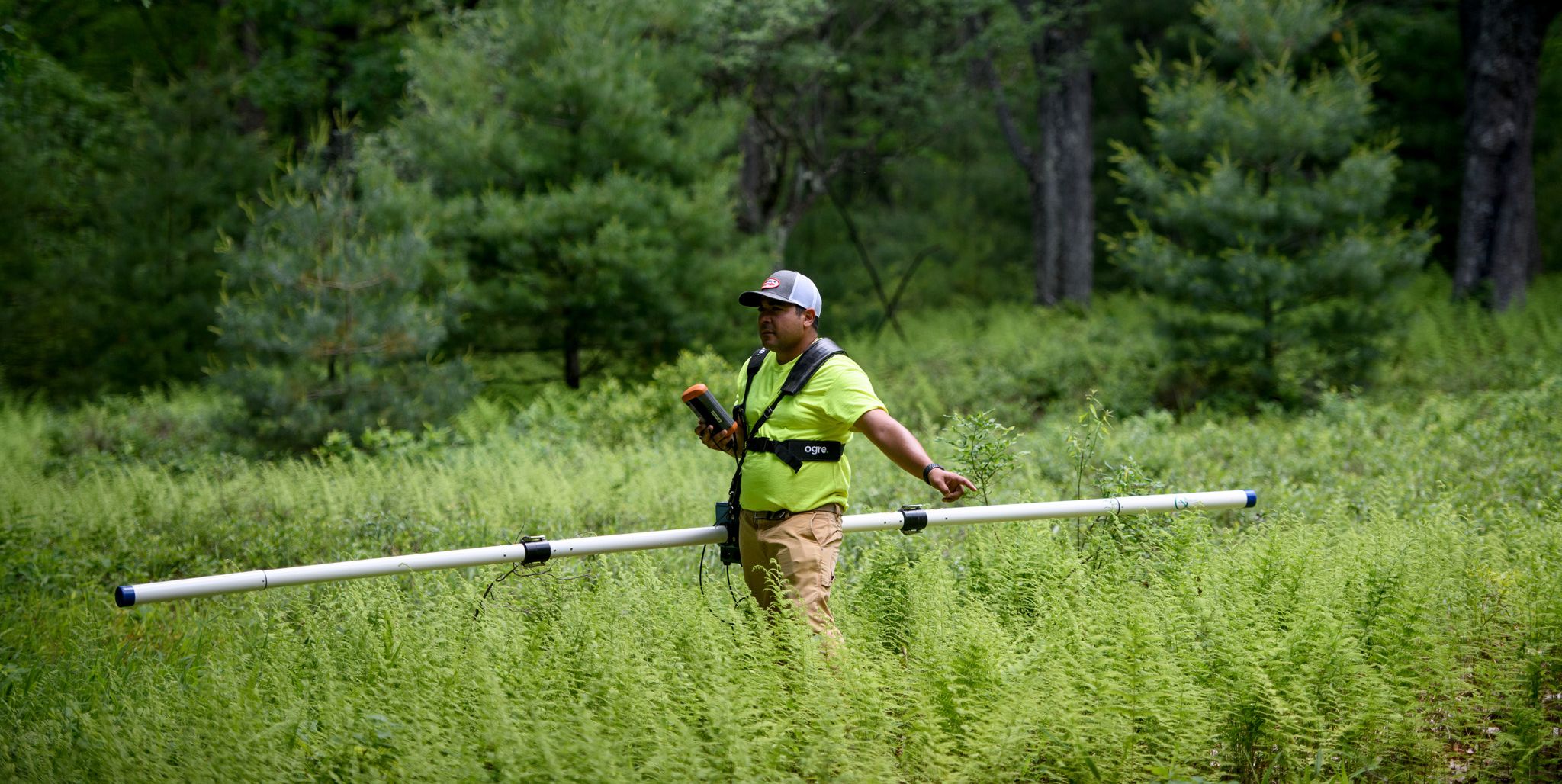
Ed Barrios, a geophysicist with American Geophysics Inc., uses an EM-31 to aid the Finders Keepers team to survey an area they believe holds historical artifacts in Clinton County, Pennsylvania, on June 9, 2021.
Advertisement - Continue Reading Below
Getler recommended several geophysics companies that could conduct tests, and the bureau chose Enviroscan Inc., a respected firm in Lancaster, Pennsylvania, with more than 25 years in business, to conduct a gravimeter survey. Enviroscan’s principal geophysicist was Dr. Tim Bechtel, who in 2020 would be awarded the prestigious Public Service Award by the Geological Society of America. Four FBI agents returned on February 23 with an Enviroscan team, and with the Paradas looking on in a bone-cold, heavy downpour, the crew festooned the site with about 60 marker flags and logged more than 50 readings over two-foot increments.
During a three-way call with Denny Parada and Getler several days later, Archer delivered Enviroscan’s findings: The gravimeter showed a mass with a density of 18 to 19—a result that indicated gold. And no small amount, either: The estimate was seven to nine tons. This was far more than the 26 gold bars from the Dents Run legend, which combined would have weighed only 1,300 pounds.
Parada’s mind reeled. Getler began bellowing. Nine tons of gold would be the largest land-based treasure in U.S. history—a haul worth $400 million to $600 million. The finding reinforced Getler’s theory that the site was an underground Copperhead depository.
Advertisement - Continue Reading Below
Archer said the FBI intended to get a warrant to excavate the site. He asked Denny and Kem to hide more cameras up there, and to check on the site as often as possible. Just over a week later, on March 10, Archer called again with news: The dig would happen in three days.

By the time Denny Parada woke on the morning of March 13, 2018, he’d had little time to digest the magnitude of what was happening.
The FBI had worked quickly. Citing the Enviroscan findings and Getler’s historical research, the bureau on March 9 had obtained a federal warrant to dig up the hillside. Archer had written an affidavit stating there was “probable cause to believe that, in a cave on the Dents Run Site, approximately one or more tons of gold belonging to, and stolen from, the United States Mint… are secreted.” In signing the warrant, U.S. Magistrate Judge Richard Lloret had asserted the federal government’s power to push aside the state of Pennsylvania in a quest to reclaim gold that had been lost 155 years earlier. Archer wrote that he wanted to dig in secret, because tipping off state officials “could result in unlawful seizure of the stolen United States gold as abandoned property.” The federal government wanted to grab the gold before Pennsylvania could.
The affidavit is a fascinating 32-page document. Archer consulted experts from the National Archives, U.S. Mint, and other historical sites. He cited the lack of naturally occurring precious metals in the area, and spelled out the scientific rationale for a dig. The affidavit also reports the incident in which a Pennsylvania official dangled a dig permit in exchange for gold bars, and bores deeply into Dents Run mythology, adopting Getler’s theory that the Knights of the Golden Circle left waybills, codes, and symbols such as circles, rising suns, and turtles on rocks and trees to guide people to caches. Getler said the rock formation above the cave entrance looked like a turtle shell—and turtles are among the most important KGC symbols for gold. Citing the purported leaders of the ill-fated supply wagons in the Dents Run legend, Archer wrote, “It is very likely that Castleton and O’Rourke are fake names, and are in fact, code (Castle and Rook), with Castleton clearly being used as a pointer, as ‘castle’ was the key organizing unit of this secret subversive organization and ‘rook’ was a local unit of that organization.” Although this sounds like a passage lifted from a Dan Brown novel, the KGC is a documented part of the historical record of the era.
Advertisement - Continue Reading Below
History aside, Dents Run would have remained a sleepy and largely forgotten fold in the Pennsylvania hills without the Paradas, a team of untrained but hell-bent enthusiasts who had stalked the slopes for more than a decade, lugging equipment purchased at hardware stores. Their business name is taken from a childhood taunt, and their logo looks like a 1960s-style Looney Tunes creation. Stranger still? To this day, Denny credits Mike Malley, the ESP performer, with enabling the discovery—and has offered Malley a quarter of any funds he might receive for the gold.
For his part, Malley, now 82 and living in western Pennsylvania, says the show he performed for 22 years consisted entirely of staged illusions. “I certainly don’t call myself a psychic,” Malley says. “I don’t believe in psychics.”
Still, on “very rare” instances—once every couple of decades—Malley says he’s able to intuit something. “It’s a certain feeling,” he says. “It’s like, somebody [asks] you, ‘Is it rainy outside?’ And you look outside—yeah, it’s raining. And you’re that certain of it. I can’t explain it.”
Malley, who left show business in the 1980s to sell life insurance and annuities, seems genuinely at a loss to make sense of the Dent Run episode. But he says he’s been able to intuit information about the site on multiple occasions with Parada—starting when Denny handed him the magazine and atlas.
Advertisement - Continue Reading Below
On the hourlong drive from their home base in Clearfield, Denny and Kem had the opportunity to contemplate the remarkable nature of everything that had happened up to that point. They were with Getler in Kem’s Mazda hatchback, because Archer had ordered them to travel incognito—no vehicles bearing the Finders Keepers logo. But when they arrived, Archer told them to stay in the car—the dig site was too crowded, and as a result too hazardous, to have them standing around.
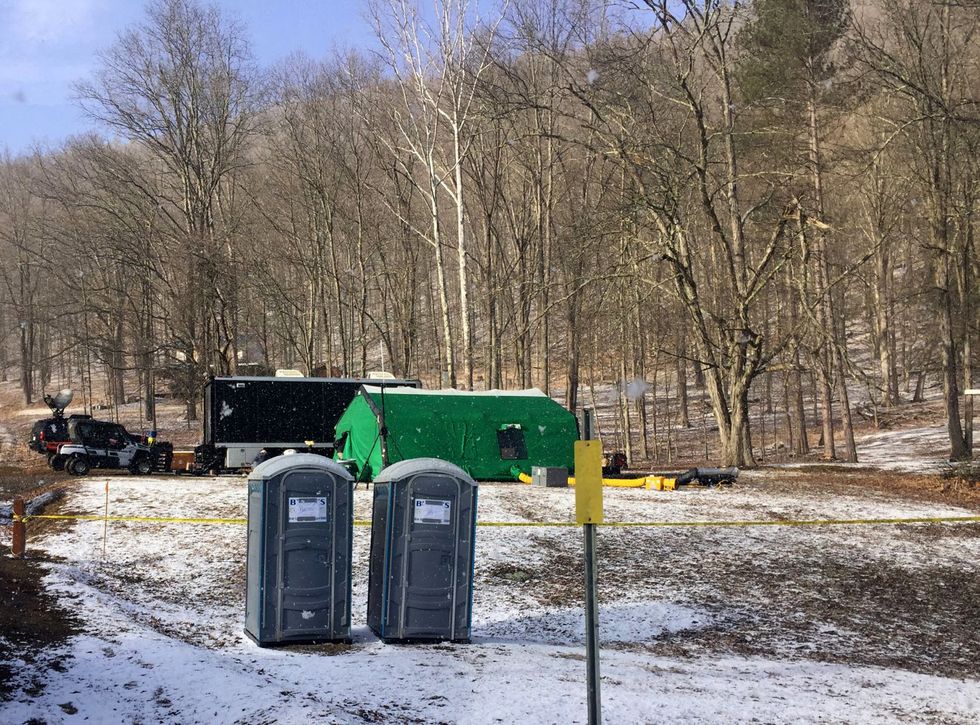
FBI agents set up a base near the dig site in Dents Run, March 12, 2018.
Advertisement - Continue Reading Below
The three men took in the scene through the Mazda windshield. The previous day, Kem had gone to check on the site and was surprised to see FBI agents already there. Now 25 vehicles sat at the base of the hill, along with four ATVs, a cargo truck, and a satellite van. At least 50 agents ringed the site’s perimeter. A staging area had been erected, including a green tent housing a command center. Portable toilets had been trucked in. They would later learn that the FBI had hired a local archeologist to provide expertise.
“There was FBI all over that mountain,” Kem says. “It blew our minds.”

Hours crawled by with the three men pinned inside the Mazda. Archer stopped by occasionally to tell them to sit tight, saying they’d be able to hike up the mountain soon, but they grew increasingly impatient. When a local TV reporter showed up, agents hustled the trio inside the tent so they couldn’t talk.
Finally, around 3 p.m., Archer led them to where the Paradas had spent countless hours over the years, many of them crawling in mud. About 30 agents wearing blue “FBI Evidence Response Team” jackets stood around a Kobelko excavator. Over the next hour, the machine dug down about seven feet before Archer called things to a halt.
As the Paradas and Getler recount, Archer said everyone was cold and hungry. “We’ve been here all day working; we’re gonna pack it up for the night,” the agent said. Archer instructed them to return at 8 a.m.
Advertisement - Continue Reading Below
The three men were surprised, because there was plenty of daylight left. When they returned the next morning under a thin snowfall, Archer reported a glitch: The hole had filled with water, and they needed to check with the DCNR about potential environmental impacts. Once again, the Paradas and Getler were confined to their car, and the mood on the site shifted. Agents who’d previously been friendly barked at them, shooing them from the tent they’d taken shelter in the day before.
After another five-hour-plus wait, Archer returned to again take them up the hill. The Paradas and Getler hustled from the car, excitement overriding their irritation—at last, they were about to see the results of their years of work. But Archer seemed downcast, as did the phalanx of agents who ringed the site. FBI personnel who had chatted amiably with them the previous day were stone-faced.
The Paradas and Getler took in the scene. The hole was free of water and mud, and had been dug 12 or 13 feet deep and about 25 feet wide. Archer asked Denny what he saw. The hole was empty. Parada replied, “I don’t see anything.”
Archer announced, “That’s it, people, there’s nothing here, let’s go home,” Parada recalls. “I say, ‘No, wait a second. There’s nothing here now. It doesn’t mean there wasn’t something here yesterday or the day before. You’re the one that told me nine tons.’”
Parada was shouting. “You’re the one that wouldn’t let my guys up here while the dig happened,” he said. “You wouldn’t let us bring equipment.”
Advertisement - Continue Reading Below
After Denny vented, Archer ushered them downhill. Denny turned and asked him: “Did you or did you not find gold?"
The agent refused to answer. Instead, Kem recalls, “Archer looked at the three of us and said, ‘I’m telling you right now, you don’t go to the media. You don’t put anything on Facebook. You put nothing online. You say nothing to nobody.’ He said, ‘If you do, there’ll be serious repercussions.’ And then he pointed at me and said, ‘and you got your law enforcement career to worry about.’”
And with that, they were dismissed. Back at the car, Getler says, “I was literally in a state of shock.”
They couldn’t make sense of it. Their own extensive testing, and tests conducted by two professional outside firms, all showed the presence of a highly conductive and very dense mass—and even if it wasn’t gold, it was something. “I’ve been in this business too long,” Parada says. “You can have a false reading… If they would have pulled out some scrap metal of any kind, I wouldn’t question it. But to tell me nothing was found? No.”
Getler observed: “When you do 50 scans with a very sensitive and precise gravimeter in five-foot increments, it’s a virtual geophysical fingerprint at that point.”
When the Paradas returned a couple of days later with their GPL 200, the mass they had detected scores of times no longer turned up in their readings. The machine showed nothing at all.
Advertisement - Continue Reading Below
That was eerie enough. Then they began to encounter people in nearby Weedville and Benezette, all of whom asked versions of the same question: “Did you see the armored trucks?”

Cheryl Elder knows what she heard.
As a resident who lives below the dig site, Elder had watched as dozens of federal vehicles rolled past and parked adjacent to her property. At 62, she’d never seen anything like it, and she’s lived her whole life in Elk County, the last 30 years in Dents Run. She served as constable for 20-plus years and had heard about the lost gold since she was a girl; her son had searched the hills with a metal detector.
The first full day they were there, she says, “I walked up, I was like, ‘What’s going on here?’ You know, you have FBI guys everywhere with their vests and guns and everything—they were guarding it. And he said, ‘Oh, nothing to worry about.’ I said, ‘Well, I live right here, I’m not worried. I mean, there’s enough FBI guys around here—why in the hell would I be worried?’”
On the night of March 13—in the hours after the FBI had sent the Paradas and Getler home—lights flooded the hillside, and Elder heard heavy work on the slope above: the sounds of a backhoe backing up, the rattling of a jackhammer. “They were digging all night up on that hill,” she says, sitting in her living room. “They had it so lit up that it looked like a city.”
Advertisement - Continue Reading Below
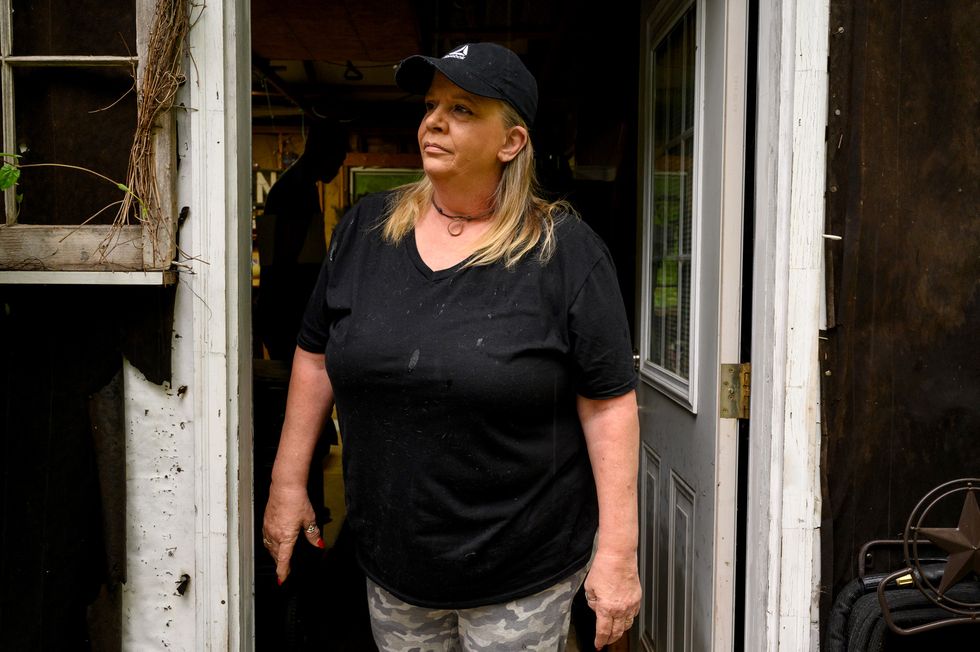
Cheryl Elder stands in the doorway of her garage at her home in Dents Run.
In the middle of the night Elder called her husband, who was out of town. “I can’t sleep,” she told him. She was awake until nearly 3 a.m.
When the FBI pulled out the next afternoon, agents blocked the road. A series of black Hummer-type armored vehicles passed, and in contrast to when they’d arrived, agents ordered her inside her house. She defiantly watched from her garage. “I just stood there with my dog watching them,” she says, “like, what are you gonna do, shoot me?”
Advertisement - Continue Reading Below
Elder was baffled to hear the FBI’s claim that the search came up empty. “If they didn’t find anything, then why?” she says. “What was the big deal? Why would you have guards there?”
“I know they found that gold,” she says.
Other residents noticed unusual traffic on March 14 as well. Heather Selle of nearby Weedville told the Paradas that she saw armored cars around 8:30 a.m. as she loaded her child off to school. The vehicles looked like Lenco BearCat-type vehicles, capable of carrying more than two tons of cargo. A local cop called Kem to report that he’d watched armored vehicles, supported by two Humvees and a satellite truck, driving west on Route 555 from near Dents Run at about 10 a.m.
“I know they found that gold.”
At Valley Farm Market in Weedville, various employees noticed FBI vehicles parked in an adjacent vacant lot for much of the day, and FBI personnel frequented the store. The shop, which features a variety of model trains and mounted deer heads, is the town’s nerve center.
Employee Mary Hogan says the FBI seemed to be mobilizing several armored vehicles. “It was an absolute circus in the vacant lot,” she says. “Why were they going through all this rigmarole if nothing was found?”
Garrett Osche also noticed that the authorities had blocked roads in and out of Dents Run that day. “You don’t shut this road down… for two to three hours to send five armored trucks out of here that have nothing in ’em,” he says. The agents, he says, were “very sneaky about it, to put it mildly… As far as I’m concerned, this totally ruined my trust in the FBI.”
Advertisement - Continue Reading Below
Getler and the Paradas believe the vehicles’ movements were orchestrated. In the morning, the armored trucks that witnesses spotted came in after the three men had arrived at Dents Run. They think the vehicles circled around behind them to nearby Hicks Run, where the gold had been stored in SUVs overnight. “They were timing us to know when we’d be off the road so that those armored cars would come in behind us,” Getler says.
The vehicles waiting at Valley Farm Market were brought in to move the rest late in the afternoon, after the trio had been sent home. “This was done with military precision,” Getler asserts.
The developments left the rural town scandalized. “This is where we live,” Cheryl Elder says. “I mean, I’ve lived here all my life… How dare they?”
The worst part, she says—beyond how the Paradas were treated—is the lack of closure. “You’re going to take the gold, but give us the story,” Elder says. “Let us have the final version of what happened here. We grew up with this legend—this myth. Maybe it was real. At least tell us.”
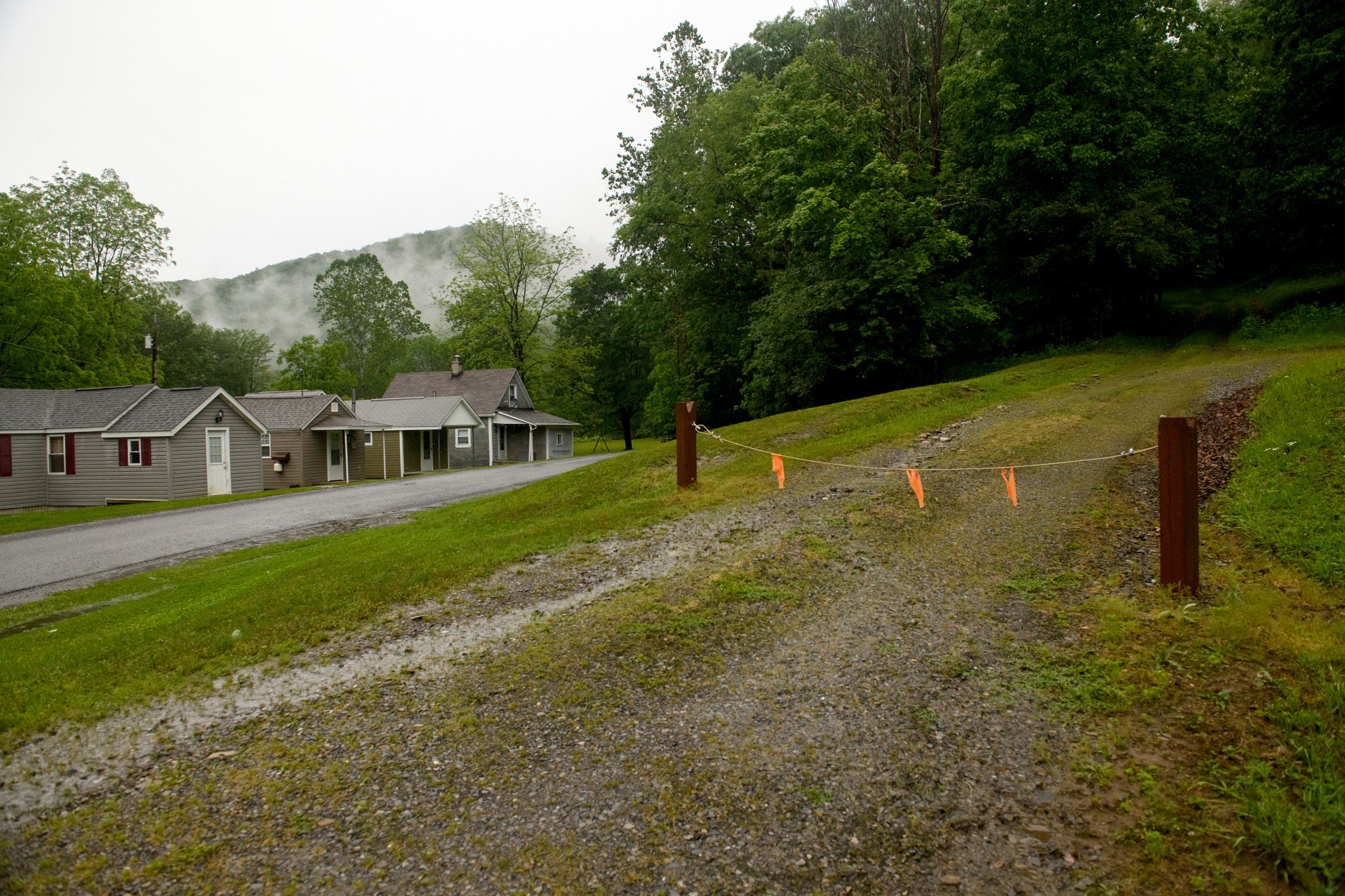
A chain blocks the road that leads to the dig site in Dents Run.
Advertisement - Continue Reading Below

The FBI issued a terse 44-word statement after the dig that stated, in part, “Nothing was found, and the excavation ended on Wednesday, March 14.” The bureau has said nothing further publicly ever since.
An FBI spokeswoman refused to make Archer available for questions. “Nothing was found in the excavation,” she declared via email. “The FBI unequivocally rejects any claims or speculation to the contrary. We’ll decline further comment.”
But the question of what happened on that hill has acquired its own gravitational pull. Emotions run high when people are short on facts. The Paradas’ attorney, Bill Cluck, filed a Freedom of Information request in May 2018 seeking records pertaining to the dig. The FBI initially responded that no such records exist, but later—after Cluck enlisted the help of U.S. Senator Pat Toomey—the bureau conceded that it possesses 2,378 pages of records and 17 CDs of videos. The file is so voluminous that the records won’t be processed for release until around March 2024. In January, Anne Weissman, an attorney who specializes in government transparency and accountability, filed a lawsuit on the Paradas’ behalf, seeking to accelerate the process.
Cluck also submitted an open-records request to Pennsylvania’s DCNR, and learned that on the day before the dig, Assistant U.S. Attorney K.T. Newton had emailed DCNR counsel to convey details about the dig. “We believe the cache itself is in the neighborhood of 3x5x8 or 5x5x8,” she wrote.
Advertisement - Continue Reading Below
Newton says the FBI was going with the best information it had at the time—that based on the results of all the testing and surveying, “it was believed that this was the size of the cache. The best we could do was use the best scientific evidence available to us at the time for probable cause: ‘This is what we believe to be there.’”
She says that turned out to be inaccurate. “The FBI and the U.S. Attorney’s Office would have been more than happy and delighted if we had uncovered what we thought was there, but nothing was found.”
For the Paradas, surreality pervaded the dig’s aftermath. Maybe the most bizarre footnote: The night the FBI packed up and moved out, Michael Malley, the psychic performer, called Parada to say that he’d intuited something. Both Parada and Getler recall Malley telling them, “They’re moving nine tons of gold out of the country.”
The next day, news broke that part of a shipment of 9.3 tons of gold had fallen from a cargo plane on a runway in Siberia. According to the reports, nearly 200 bars had come from a mine operated by the Canada-based Kinross Gold Corporation—whose initials happen to be KGC. It was almost certainly just a coincidence, Parada says, but it was still indelibly strange.
Advertisement - Continue Reading Below
The key question the treasure hunters want answered is this: How did several different scientific instruments that are staples in the geophysics industry—most specifically the gravimeter—all produce false readings? Newton was unable to account for the discrepancy. “We hire reputable companies, the testing is done, this is what the results are,” she says. “It’s never guaranteed. It’s always within—I don’t even know what the reasonable probabilities are—but we can only base it on what the testing tells us. As to what the science is and how that’s done, I am not a geologist.”
The perpetual questions about what happened are troubling, she says. “It is disturbing for us to have this still being put out there, that somehow the FBI is lying about this—that somehow this huge amount of gold was found, and we managed to spirit it out of that location in the middle of the night,” she says. “What better outcome for us than to say, ‘Look what was found,’ right? As opposed to, for some reason, this allegedly is somehow secreted away somewhere. I can’t figure out what possibly anybody would gain from that.”
When I suggest that opening the FBI records might resolve the matter, Newton disagrees. “We unsealed the affidavit, we laid out the basis for what we thought was there, and… there was nothing found,” she says. “So I don’t know what else needs to be put out in the public record on this.”
The Paradas’ lawyers disagree. “I can’t believe (FBI officials) haven’t bothered to issue a report to the federal court,” Bill Cluck says. “They haven’t bothered to get back to the companies whose equipment was used. Because frankly, I practice environmental law, and I’m not going to trust Enviroscan and this equipment now that I know it doesn’t necessarily work.”
Advertisement - Continue Reading Below
Enviroscan, unfortunately, is barred from defending itself or elaborating on its findings. “We are under quite a strict gag order,” founder Timothy Bechtel replied to an email seeking comment. “I am to direct all inquiries to Agent Jake Archer of the FBI.”
And, of course, there’s the issue of the Paradas’ unreimbursed years of work on Dents Run. Cluck says Pennsylvania is the only state that lacks a definitive supreme court decision on treasure troves, and his research indicates that by common law, Finders Keepers has a right to petition federal courts “for their fair share [of the gold], if it was found.” Parada wants a 10 percent finder’s fee—$40 million to $60 million—and he believes a confirmed finding of gold would bring book and movie rights to his story.
But Parada says money is only part of the equation. Despite the business name he chose, Parada isn’t looking to possess any of his discoveries; he wants various finds returned to their rightful owners, if possible. If gold buried at Dents Run bore the markings of the U.S. Mint, he accepts that it’s government property. And when he leans away from the specifics of Dents Run in his mind, he sees something bigger: Malley’s help, along with other unspecified supernatural occurrences he declines to elaborate on, have convinced him that spirits of the departed help guide his efforts. He believes they want “somebody to come around to find these things and make sure they go to the right place. If souls that have crossed over are helping us, that means there’s an afterlife, and that’s a good thing.
Advertisement - Continue Reading Below
“I know it sounds crazy,” he adds after a beat. “But this is my life.”
Malley feels conflicted about his role in what he characterizes as a borderline unhealthy quest. He’s suggested to Parada multiple times that he let Dents Run go. “It became an obsession, in my mind, of him going after (the gold),” Malley says. “I mean, no matter how hard I tried to talk him out of it, he wouldn’t budge… I said, ‘Dennis, this is too consuming for you; it’s not going to go anywhere.’ And he said, ‘I can’t stop now, Mike.’”
The layers of irony are unfathomably rich: Parada became convinced of psychic powers—and was propelled in his quest—by a performer who doesn’t believe in psychic powers. And he embraced the FBI in order to solve his life’s biggest mystery—and wound up with an even bigger one. Before, Parada was merely looking for the X that marks the spot; now, the answer resides inside a hall of mirrors—the treasure there but not there, seemingly receding further from him the closer he gets.

Denny Parada at his home in Clearfield, Pennsylvania.
Advertisement - Continue Reading Below
Parada’s unselfconsciousness through it all is both unsettling and disarming. He’s able to stand apart from his narrative, observe how absurdly unlikely it is, and then use that awareness to argue even more convincingly on his own behalf. Most people in his situation would cave in to exasperated uncertainty; his adversity and lived experience has only ripened into deeper conviction. He has no trouble reconciling the life that he’s lived to the one he imagines. His redemption could always be just a few shovelfuls of dirt away.
“All I want is credit for solving these mysteries,” he says. “So many people have died for those treasures to be there. It’s not ours. The last thing we’d ever do is dig something up and put it in our pocket and never tell anybody. More than anything, I want the truth to come out. I wanna know where that gold went to.”

The good news for the Paradas is that they always have a new mission.
The day after visiting Dents Run in summer 2021, the Paradas and Getler take me to another site they’re investigating nearby. After the FBI dig, Denny received a call from a man who had grown up in an area known for harboring unidentified mounds and Civil War-era artifacts.
Exploring the site, the Finders Keepers team discovered what they believe are bullets, belt buckles from Union uniforms, and parts of a limber wagon, a two-wheeled cart that carried ammunition and artillery. They also found Knights of the Golden Circle symbols, including a circular stone carved in the shape of a Native American headdress similar to what appears on a copperhead penny. One of the team also found a “turtle rock”—a stone with an image of a turtle on it. Unfurling the map beforehand, Getler points to the spot. “That’s a turtle, no question,” he says. “If you read my book, the turtle always points to the treasure.” Getler also located a waybill—a KGC coded map—that matches certain features of the area.
Advertisement - Continue Reading Below
The group returned with their array of detection equipment and located more underground metal masses and what appeared, on their instruments, to be a tunnel. Measuring off distances, they created a massive hand-drawn map. These efforts yielded an astonishingly far-reaching theory: They believe they’ve located a buried KGC garrison. Fifteen feet underground, they say, is essentially a military base the size of three football fields. Numerous tunnels lead to as many as 21 chambers potentially harboring Civil War cannons, arms, ammunition, and more. “I think every wagon they hijacked for gold or supplies, they brought back to this camp and buried them all,” Denny says.
If they’re correct about what they call Copperhead Central, they believe the site will rewrite history books. They theorize that it was the secret rendezvous point for General Robert E. Lee and his troops in late spring 1863—to collect looted gold and link up with KGC militia—when they fatefully ran into Union forces at Gettysburg. “If this is right,” Getler says, “you’re on to the biggest story you could ever imagine in terms of how outrageously wild it is.”
Their collective quest exists inside the space where the supernatural meets science, ardent belief meets cold reality, and heat maps meet hard earth.
Advertisement - Continue Reading Below
Back in Clearfield, in the low-slung, tucked-away home that serves as the Finders Keepers headquarters, the three men unfold their map, several square feet in area, onto which they’ve overlaid a transparency showing the theoretical KGC compound. Items from Denny’s years of exploration, many of them rusty and crumbling, cover nearly every horizontal surface. A New York Times story about Finders Keepers, which includes a photo of Parada, hangs on the wall.
As with Dents Run, the Paradas are endeavoring to gird their towering theories with a scientific foundation. They’ve hired a New Jersey outfit, American Geophysics Inc., to scan the location using ground-penetrating radar and an EM-31. On the first of two days at the site, two members of the American Geophysics crew walk the site, flagging the ground at locations indicated by Parada and Getler. Then they scan it with their gear, which includes a 12-foot boom.
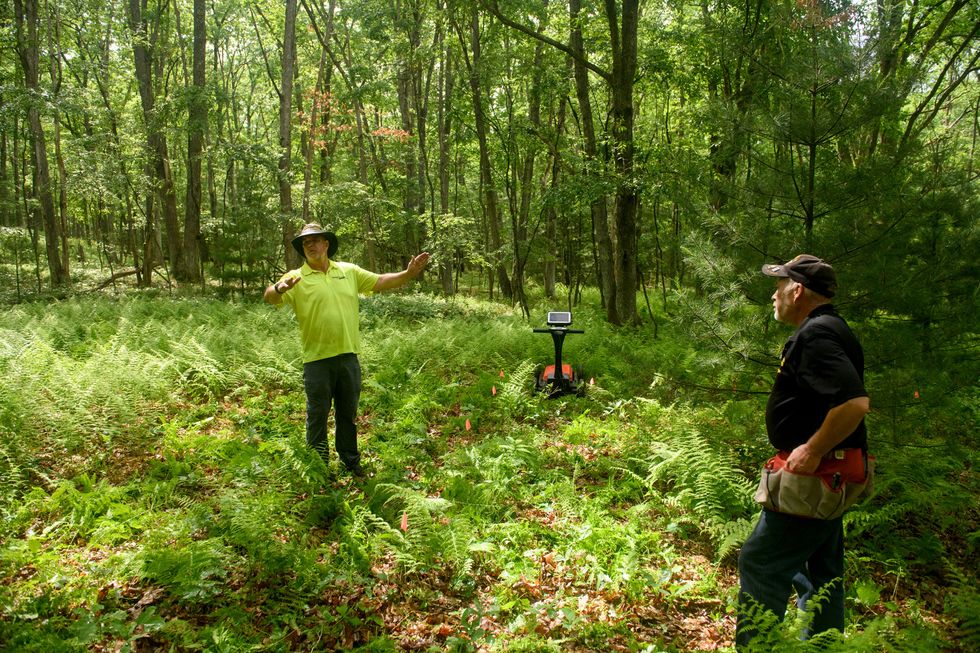
Daniel Jonasz, owner of American Geophysics, left, explains the findings from the ground penetrating radar at the "Copperhead Central" site.
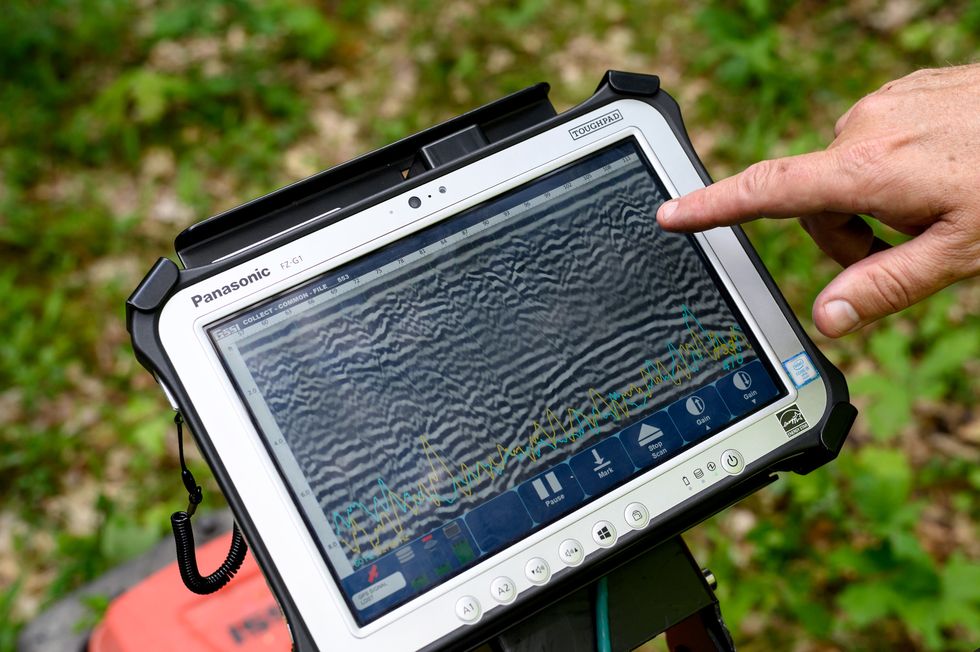
The screen of his ground penetrating radar used by American Geophysics.
Advertisement - Continue Reading Below
Getler and the Paradas buzz with anticipation—but they’re also aware that the science may reveal gaps between their ironclad convictions and the reality of what lies underground.
DCNR District Forester Douglas D’Amore, for one, is expecting the team of treasure hunters to leave the site disappointed. D’Amore is on site, watching and taking photographs, to ensure that the activity conforms to approved activities—scanning, but no digging. Parada regales him with earnest, bubbling-over theories about Copperhead Central, but D’Amore no-sells the pitch, standing with his body angled away and avoiding eye contact. Later, D’Amore offers a detailed alternative theory: Whatever lies underground on the site is far more likely the result of logging operations that were based there.
It’s not hard to channel D’Amore’s skepticism, trudging among the trees. The surroundings feel like one unremarkable patch of woods among hundreds of square miles of them. And the dynamic between the Paradas and Getler could be read as endlessly looping confirmation bias. Then there’s the zealous embrace of the supernatural and the unreconstructed use of dowsing rods. Yet everyone involved—Denny most of all—argues their case with the ferocity of a true believer. And in his contempt for government interference, Denny tends to characterize any bureaucratic speed bump —for example, the DCNR’s environmental permitting requirements—as evidence of persecution and obstruction.
Advertisement - Continue Reading Below
Their collective quest exists inside the space where the supernatural meets science, ardent belief meets cold reality, and heat maps meet hard earth. They see themselves as an unstoppable force pitted against a movable object—if only they exert enough sweat and resources. It’s a years-long grind that few beyond the Paradas would countenance.
But: The American Geophysics crew produces a heat map showing four large, anomalous metal shapes underground, including a 10-foot mass. Optimism pulses through the gathering, and the Finders Keepers crew, feeling exultant, convinces D’Amore to try the dowsing rods.
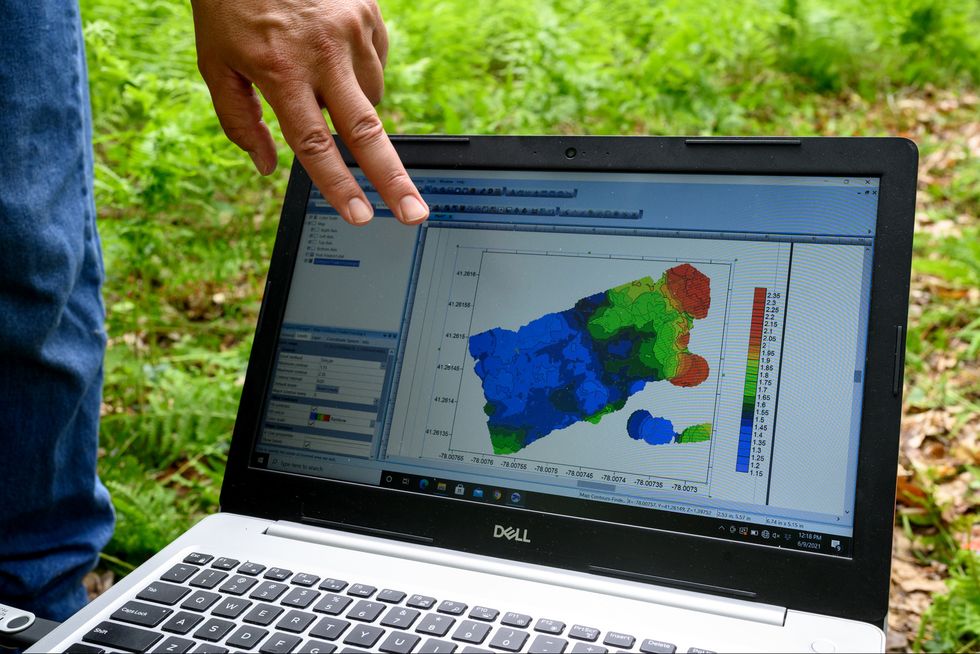
A heat map captured by American Geophysics at the Copperhead Central site.
Advertisement - Continue Reading Below
After receiving the final results from American Geophysics, the Paradas ask the state of Pennsylvania to excavate the site. When several months pass with no answer, Parada looks into obtaining permits to start digging, in the hope that a remarkable discovery will prompt an official entity—a museum or university—to take over.
For now, that leaves the Paradas in a kind of treasure-hunter limbo. If the truth emerges that tons of gold bars were on that Pennsylvania hillside, the story of their ardent and tenacious journey will become just as mythical and enduring as the cache of precious metal. Somehow, the scaffolding of belief they built around the site held up across more than a decade of gale-force bureaucratic headwinds.
And maybe that’s the point of the bizarre tale of Dents Run. Maybe the truth of the gold—tantalizing though it may be—doesn’t really matter. Maybe what’s important is the manner in which Denny Parada embodies the yearning, the quest—the believing—for objects that transport us, time out of mind, to distant people and times. Who doesn’t yearn to follow the map to the mythical X, to crunch through the woods, staring at the ground, wondering what mysteries it holds?
Of course, the most likely answer is that there’s nothing down there. But what if?
Watch Next

David Howard has written for many national publications and is the author of two nonfiction books, most recently Chasing Phil: The Adventures of Two Undercover Agents with the World's Most Charming Con Man.